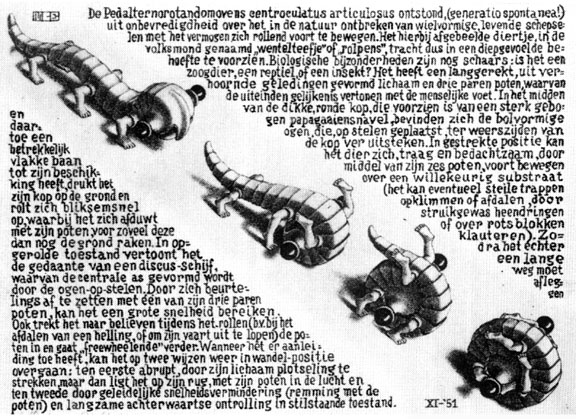 |
|
|
| Hop,
Now that school is on break, I had time to sit down and translate Escher's curl-up note. I don't know why he didn't write professionally (maybe he did) .....This note is fantastic! Too bad it loses some of its "power" in the translation; but that is probably a result of my own limited language abilities. Dutch sentence structure is dramatically different than English, and they have "spreek-woorden" that are a bit like colloquialisms.....Only different (that brief preface should cloud things right up!). Anyway, the tone of the letter is scientific; as though he is presenting preliminary findings to a group of colleagues. In my opinion, this note gives strong support to the potential value of the curl-ups as a concept for an exploratory probe; or perhaps a new generation of sophisticated off road (no road needed) vehicle. Okay, Iím babbling, so here you go: "The curl-ups* came into existence (spontaneous generation), because of the absence, in nature, of wheel shaped, living creatures with the ability to roll themselves forward. The accompanying 'beastie' depiction, referred to as 'revolving bitch' or 'roll paunch' in laymen's terms, subsequently anticipates the need with sensitivity. Biological details are still few: is it a mammal, a reptile, or an insect? It has a long, drawn-out, horned, sectioned body and three sets of legs; the ends of which look like the human foot. In the middle of the fat, round head, that is provided with a strong, bent parrots beak, they have bulb-shaped eyes, which, placed on posts, protrude far out from both sides of the head. In the stretched out position, the animal can, slow and cautiously, with the use of his six legs, move forward over a variety of terrains (it can potentially climb or descend steep stairs, plow through bushes, or scramble over boulders). However, when it must cover a great distance, and has a relatively flat path to his disposal, he pushes his head to the ground and rolls himself up with lightning speed, at which time he pushes himself off with his legs- for as much as they can still touch the ground. In the rolled up state it exhibits the form of a discus, of which the eye posts are the central axle. By pushing off alternately with one of his three pairs of legs, he can achieve great speeds. It is also sometimes desirable during the rolling (i.e.. The descent of an incline, or coasting to a finish) to hold up the legs and 'freewheel' forward. Whenever it wants, it can return again to the walking position in two ways: first abruptly, by suddenly extending his body, but then it's lying on his back with his legs in the air, and second through gradual deceleration (braking with his feet) and slowly unrolling backwards in standing position." -MCE- *Curl-Ups is what I used; but you may notice that Escher came up with a Latin title "Pedalternorotandomovens Centroculatus Articulosus" A few years back, the guys at M.I.T.. Started switching their focus in robotics to "instinctive" neural networks. Insects are the inspiration for all the designs. Some would scoff at my next statement, but I think Escher was a classic "genius ahead-of-his-time" who can be likened to Da Vinci. Carlton Leuven
|